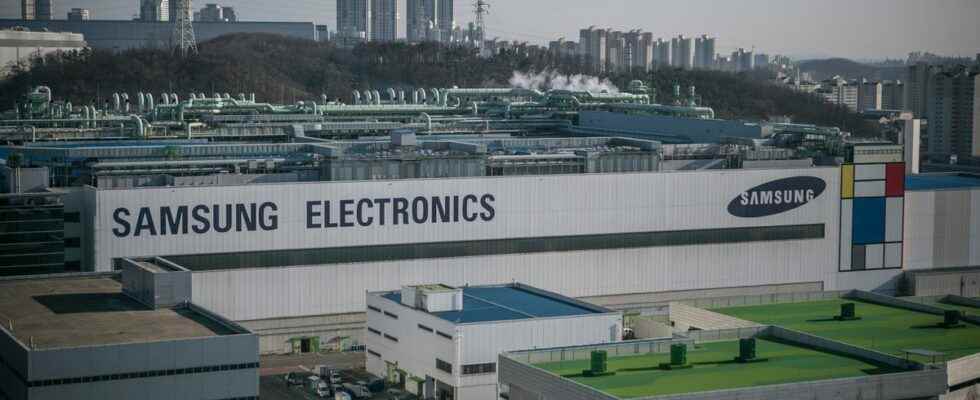The machine greenwasher running at full speed at Samsung, which has just presented its “new” ecological commitments. Carbon neutrality, circularity, energy efficiency, water conservation, depollution, etc. : There is something for every taste. We would almost forget that less pollution and more green energy is always a lot of pollution and resources drawn from planetary limits, especially when we talk about the activity of a global consumer electronics giant. . Measures by which Samsung hears no matter what “overcoming the climate crisis”. Hard to believe, but definitely worth a try. And if this can lead to a reduction in the environmental impact of the group’s activities, it is always better than nothing.
The South Korean chaebol therefore evokes its new “environmental strategy”. First point, its recommitment to achieving carbon neutrality for all its consumer products in 2030, before including its memory, system and foundry divisions in 2050. We are talking about trying to reduce carbon emissions as much as possible. carbon equivalents of its industrial processes and overall operation (i.e. 17 million tonnes in this case), offsetting all remaining emissions. To do this, the company will be able to finance forest maintenance initiatives or buy “pollution certificates” on the market. It will also be able to count on its ambitions in terms of carbon capture, an area in which it began to invest in 2021.
South Korea lagging behind on renewable energy
In the shorter term, in five years, the company undertakes to respect the commitments of the RE100 initiative which it has joined: to do so, it will have to buy as much green energy as it consumes, which indirectly encourages energy suppliers to increase their renewable energy production capacity. An objective that concerns all of Samsung’s international markets, the company leaving itself until 2050 to consume 100% renewable energy on its land in South Korea. It must be said that it has the majority of its most energy-consuming factories there and that these are running at full speed (even gaining in capacity) to meet global demand. Moreover, South Korea is one of the countries where it is currently the most difficult to obtain renewable energies.
Among Samsung’s other commitments is the manufacture of ever more energy-efficient devices. The company is increasingly relying on low-power electronic chips for this purpose, and is committed to ensuring that the average operating power consumption of seven product categories (smartphones, refrigerators, washing machines, air conditioners, televisions, monitors and computers) will be reduced by 30% in 2030 compared to the performance of the 2019 ranges. That is nearly a third less electricity consumption in the space of 11 years. This may sound ambitious, but actually tracks progress quite closely over time.
Water consumption, a real subject
It is obviously impossible to talk about eco-gestures without mentioning circularity. Samsung pledges to reuse materials from used batteries and have 50% of plastics in its products incorporate recycled resin by 2030, which will include expanding its e-waste collection network to 180 countries (compared to around fifty today). Between 2010 and 2030, 10 million tonnes of waste should have been collected, with an emphasis on reusing smartphone components (particularly on the Internet of Things market). The company also wishes to improve its supplies of raw materials, including rare earths and metals, so as to limit its environmental impact. A wishful thinking.
Finally, while the water consumption of Samsung’s factories in Korea is expected to double by 2030, the company wants to improve its water reuse circuits in order to stabilize its consumption at 2021 levels. will thus engage in “water restoration” projects and improve its quality, while generalizing its water depollution processes to limit its impact before 2040. Water, as we now know, is a very important subject for the future as its cycle is disrupted by global warming and as it becomes polluted, including rainwater.
Technology will save us, or not…
“The climate crisis is one of the greatest challenges of our time. The consequences of inaction are unimaginable and require the contribution of all of us, including businesses and governments […] Samsung is responding to the threats of climate change with a comprehensive plan that includes reducing emissions, new sustainability practices, and developing innovative technologies and products that are better for our planet.”says Jong-Hee Han, general manager of Samsung Electronics.
Unsurprisingly, technological solutionism is present at all levels at Samsung and at no time is the (big) word sobriety used. Of course, some of the company’s initiatives are laudable, and even desirable, but we are still waiting for a global electronics giant to come out with extremely positive cliches and other mantras of the kind “if we do all the right things, a better future is possible”. It is indeed difficult to hear Samsung talk about circularity and recycling, without mentioning the eco-design of electronic products with hundreds of components that are increasingly difficult to recycle.
What does the manufacturer plan to extend the life of its smartphones, televisions, computers, when the environmental bill of an electronic product is generally the consequence of its manufacture up to 70%. Who, the first, will take the commercial risk of assuming a drastic reduction in the number of products in its catalog, or a lengthening of commercial cycles so that its new products only see the light of day every two to three years, fighting in passing against the early renewal of functional devices? Obviously, neither Samsung nor the shareholder are ready yet.
